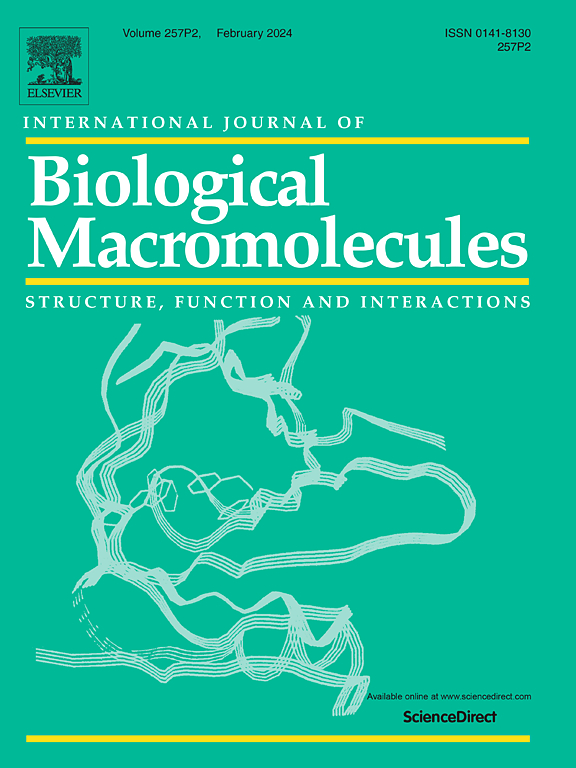植物提取物和壳聚糖共改性淀粉生物炭吸附Cu(II)和Pb(II)的机理
IF 7.7
1区 化学
Q1 BIOCHEMISTRY & MOLECULAR BIOLOGY
International Journal of Biological Macromolecules
Pub Date : 2025-07-12
DOI:10.1016/j.ijbiomac.2025.145971
引用次数: 0
摘要
为研究淀粉(S)基材料对重金属离子的吸附机理,采用400℃厌氧煅烧法制备了S型生物炭(SB),然后用植物提取物(E)和壳聚糖(C)对其进行单次和联合改性,分别得到E改性SB (E-SB)和E/C共改性SB (E/C-SB)。采用多种分析技术对E- sb和E/C-SB的形态特征进行了表征。通过批量实验考察了温度、pH和离子强度对Cu(II)和Pb(II)吸附的热力学和动力学行为的影响。E和C改性改变了SB的理化性质,并在其上引入了官能团。改性后,E-SB和E/C-SB的孔隙结构变得更加多孔,形成了孔隙分布不均匀的网状结构。与未改性的SB相比,改性SB的热塑性性能得到了提高。Langmuir模型比Freundlich模型更能描述吸附等温线。对Cu(II)和Pb(II)的最大吸附量分别为696.29 ~ 1290.98 mmol kg - 1和238.16 ~ 643.60 mmol kg - 1,顺序为:E/C-SB >;E-SB祝辞热力学和动力学分析表明,Cu(II)和Pb(II)的吸附是吸热的、自发的、熵驱动的,主要受传递阻力的控制。较高的温度和pH值,以及较低的离子强度,促进了吸附。经过3次再生循环,E/C-SB对Cu(II)和Pb(II)的吸附量分别保持了74.9%和67.0%。本文章由计算机程序翻译,如有差异,请以英文原文为准。
Adsorption mechanism of Cu(II) and Pb(II) by starch biochar co-modified with plant extract and chitosan
To investigate the adsorption mechanisms of heavy metal ions by starch (S)-based materials, S biochar (SB) was prepared by anaerobic calcination of S at 400 °C for 2 h. Plant extract (E) and chitosan (C) were subsequently used for single and combined modifications of SB, yielding E-modified SB (E-SB) and E/C co-modified SB (E/C-SB), respectively. The morphological features of E-SB and E/C-SB were characterized using multiple analytical techniques. Thermodynamic and kinetic behaviors of Cu(II) and Pb(II) adsorption were evaluated through batch experiments, examining the effects of temperature, pH, and ionic strength. E and C modification altered the physicochemical properties and introduced functional groups onto the SB. After modification, the void structures of E-SB and E/C-SB became more porous, forming a mesh-like structure with uneven pore distribution. The thermoplastic properties of modified SB was enhanced compared to unmodified SB. Adsorption isotherms were better described by the Langmuir model than by the Freundlich model. The maximum adsorption capacities for Cu(II) and Pb(II) ranged from 696.29 to 1290.98 mmol kg−1 and 238.16–643.60 mmol kg−1, respectively, following the order: E/C-SB > E-SB > SB. Thermodynamic and kinetic analyses indicated that Cu(II) and Pb(II) adsorption was endothermic, spontaneous, and entropy-driven, primarily governed by transfer resistance. Higher temperature and pH, and lower ionic strength, promoted adsorption. After three regeneration cycles, E/C-SB retained 74.9 % and 67.0 % of its original adsorption capacity for Cu(II) and Pb(II), respectively.
求助全文
通过发布文献求助,成功后即可免费获取论文全文。
去求助
来源期刊
CiteScore
13.70
自引率
9.80%
发文量
2728
审稿时长
64 days
期刊介绍:
The International Journal of Biological Macromolecules is a well-established international journal dedicated to research on the chemical and biological aspects of natural macromolecules. Focusing on proteins, macromolecular carbohydrates, glycoproteins, proteoglycans, lignins, biological poly-acids, and nucleic acids, the journal presents the latest findings in molecular structure, properties, biological activities, interactions, modifications, and functional properties. Papers must offer new and novel insights, encompassing related model systems, structural conformational studies, theoretical developments, and analytical techniques. Each paper is required to primarily focus on at least one named biological macromolecule, reflected in the title, abstract, and text.

 求助内容:
求助内容: 应助结果提醒方式:
应助结果提醒方式:


